|
 Secure Site
Secure Site
|
 |
Archive for the 'Yoga Timer' Category
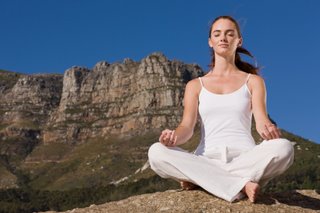 mindfulness practice Practice limitless awareness and let yourself be as infinite as the heavens.
This is the first guided meditation in a series of three that starts today:
Create a comfortable, stable, supported seated posture. If sitting on the floor, support your knees with pillows or blocks. Sit upright and close your eyes. Let your breath flow naturally, without manipulating it. Rest your attention on the rising and falling of your belly or chest.
Imagine a majestically tall mountain. Contemplate how solid and stable the mountain is throughout the changing seasons. At times the mountain may be clouded over, its peak covered in fog. Sometimes the mountain is assaulted with thunder, lightning, and heavy rains. Sometimes it rises into a clear blue sky or a few white puffy clouds. At times it is covered in snow, at times with lush foliage, and at other times it is barren. Throughout, it remains stable and unaffected by the changing weather or seasons. Let this stable quality of “mountainness” nourish your concentration and your ability to sit through all the varying experiences that arise while practicing this meditation.
Now feel your posture to be like a mountain. Breathing in, see yourself as a mountain; breathing out, feel stable. Some thoughts and emotions are like storms, others like sunshine. Your mind can be clouded over or clear and bright, but through it all, you can still sit solid.
adapted from Yoga Journal by Frank Jude Boccio
Although meditation can be done in almost any context, practitioners usually employ a quiet, tranquil space, a meditation cushion or bench, and some kind of timing device to time the meditation session. Ideally, the more these accoutrements can be integrated the better. Thus, it is conducive to a satisfying meditation practice to have a timer or clock that is tranquil and beautiful. Using a kitchen timer or beeper watch is less than ideal.
 Portable Meditation Timer with Chime And it was with these considerations in mind that we designed our digital Zen Alarm Clock and practice timer. This unique “Zen Clock” features a long-resonating acoustic chime that brings the meditation session to a gradual close, preserving the environment of stillness while also acting as an effective time signal.
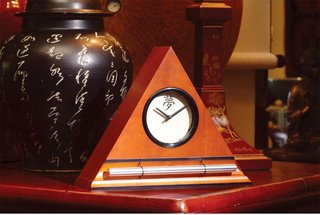 meditation and yoga tools Now & Zen – The Portable Meditation Timer Store
1638 Pearl Street
Boulder, CO 80302
(800) 779-6383
Posted in yoga, Yoga Timer, Yoga Timers by Now & Zen
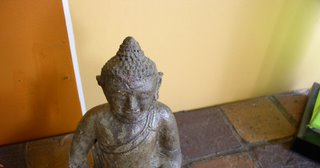 buddha When you deny the reality of life, you appreciate it less. Meditate on the Buddha’s Five Remembrances and rediscover the magic of life just as it is.
Ignorance, or avidya, is a root cause of suffering, according to Patanjali’s Yoga Sutra (II.5). But the ignorance Patanjali refers to is less a lack of knowledge than an almost willful ignoring of reality. Today we call it denial. For instance, we may intellectually know that all things change, yet we desperately deny this truth—a denial that leads to anxiety, fear, and confusion.
At a recent lecture, I led a group of interfaith seminarians in the contemplation of the Five Remembrances, Buddha’s teaching on impermanence, aging, health, change, and death. Afterward, one of the students asked, “Isn’t this just negative thinking?” On the contrary, the Five Remembrances is what the Buddha offers to awaken you from denial, to cultivate gratitude and appreciation for the life you’ve been given, and to teach you about nonattachment and equanimity.
One way of practicing the Five Remembrances is through something Buddhist master Thich Nhat Hanh calls hugging meditation. When your partner or children leave for work or school, hug each other for three full breaths, and remind yourself of the Fourth Remembrance: “All that is dear to me and everyone I love are of the nature to change. There is no way to escape being separated from them.” If you’re having a disagreement with someone, remind yourself, before getting swept away by heated emotions, of the Fifth Remembrance: “My actions are my only true belongings. I cannot escape the consequences of my actions. My actions are the ground upon which I stand.” None of this means you should be passive or reluctant to advocate your views. Instead the meditation helps you respond more skillfully with awareness of how things truly are rather than from conditioned reactions.
The Five Remembrances
I like this version of the Buddha’s Five Remembrances, offered by Thich Nhat Hanh in The Plum Village Chanting Book (Parallax Press, 1991).
I am of the nature to grow old. There is no way to escape growing old.
I am of the nature to have ill health. There is no way to escape ill health.
I am of the nature to die. There is no way to escape death.
All that is dear to me and everyone I love are of the nature to change. There is no way to escape being separated from them.
My actions are my only true belongings. I cannot escape the consequences of my actions. My actions are the ground upon which I stand.
Frank Jude Boccio (www.judekaruna.net) is the author of Mindfulness Yoga. He teaches yoga in New Paltz, New York, and leads Mindfulness Yoga sessions throughout North America.
adapted from Yoga Journal by Frank Jude Boccio
 gentle chime timer for mindfulness practices Now & Zen
1638 Pearl Street
Boulder, CO 80302
(800) 779-6383
Posted in yoga, Yoga Timer, Yoga Timers by Now & Zen
 awareness Sometimes the fastest way to speed things up is to slow down. Try this slow-motion hand meditation to clear your mind.
Recently, I made a list of things I wanted to accomplish. It was much too long and ambitious—but I geared up to move on all fronts anyway. After some exasperation at the slow headway I was making, I sat down with a wise friend for some counsel. “It sounds like you want to get a lot of things done,” he said.
“Absolutely,” I replied. “But I’m frustrated at this pace.”
After a long pause he replied, “If you really want to speed things up, you have to slow down first.” Much as I wasn’t ready for that bit of wisdom, once I tried slowing down, I realized he was right. By slowing down I became more relaxed and clear. I was able to trust my intuition and choose the best steps for the projects that truly resonated with my highest aspirations.
TAKE A BREAK
In our hyped-up and caffeinated culture, who doesn’t want to do more faster? But you may also crave a break from your overstimulated mind and aspire to a calmer, more intuitive, and present state. It’s easy to lose sight of your main purpose amid the distractions of a frenzied mind. Slowing down brings you back to the here and now.
Many meditation techniques use one point as an object of concentration. Whether it’s the breath, a mantra, sensations, the thought of love, or awareness itself, the object of concentration can be a doorway to the moment. But sometimes this single focus is too subtle for the mind to track easily. If that’s been your experience, you may find that slow-motion movement, which begins with attention to strong sensations in the body, to be a more tangible and satisfying focal point.
This process of gradually shifting your attention from the large movement of the asanas to the small movements of the breath is the essence of raja yoga. As you attend to the postures, you encounter and release deep-seated tensions. You also refine your awareness by concentrating on the subtlety of your breath and turning inward (pratyahara). From there you can move to increasingly subtler forms of mindfulness, from one-pointedness (dharana) to one-flowingness (dhyana) to absorption (samadhi).
A wonderful and accessible means of moving meditation involves concentrating on the slow movement of your hands. (See “Try Your Hand,” end of article.)
FEEL THE FORCE
Any meditation practice quickly reveals how your mind is habitually consumed by thoughts of the future or past. Moments of awareness in the present are comparatively few, but slow-motion movement, because it captures your mind’s attention, can draw you directly into experiencing the sensations of the present moment. This technique can pull your mind into one-pointed concentration forcefully, but it also has larger implications as you become more sensitive to the life force.
Many yogis believe that life force, or prana, runs your autonomic nervous system, animating your body and keeping all systems working at optimal levels. Usually, your mind submits to the healing presence of prana when you’re sleeping, which is why a good night’s sleep can be so restorative.
However, you can learn to tune in to prana when you’re awake and to build reserves of it.When you remove obstacles to free-flowing prana, you feel more alive and present in your life. Think of how great you feel after a yoga class or a night of dancing or making love. Movement can awaken both prana and awareness.
Slow-motion movement slows your mind. Just a few minutes of it before sitting is an excellent segue to a more subtle meditation practice. Try lifting your arms overhead and slowly releasing them to your sides, concentrating on the micro-movements of your hands as they flow through space. Just a minute of this helps you move into pratyahara, sense withdrawal.
Paying attention to slowing down helps you be mindful during the day. Try brushing your teeth or washing dishes more slowly and see how that brings your mind into the present. Slowing down a yoga pose also helps draw you into a dynamic flow of sensation, breath, and awareness.
A fascinating paradox emerges when you allow yourself to become absorbed in the small details of any physical action. Embracing movement, you are inexorably drawn to the stillness within.
adapted from Yoga Journal by Jonathan Foust
 Yoga Timers with gentle chimes Now & Zen
1638 Pearl Street
Boulder, CO 80302
(800) 779-6383
Posted in yoga, Yoga Timer, Yoga Timers by Now & Zen
 sleeping Side Sleeping
Benefits Helps keep spine aligned and reduces snoring.
Get into bed and turn to one side. Put a pillow between your knees and another under your head for support. Your head pillow should be just high enough to prevent your neck from side bending up or down; your whole spine should be straight when viewed from the side. Draw your bottom elbow and shoulder forward far enough so you do not lie directly on your arm. Optionally, place a third pillow in front of you and support one or both hands on it.
adapted from Yoga Journal byNora Isaacs
One of the ultimate Zen like experiences is waking-up from a great slumber refreshed and energized. Your mind and body are harmoniously one, both alert and focused. Having a refreshed mind and body are two keys to a natural and Zen lifestyle. Waking up in the morning should not be a loud and abrupt awakening, but rather it should be a peaceful positive experience. The right natural alarm clock can transition your deep and tranquil sleep into a serene start to consciousness. Imagine a long-resonating Tibetan bell-like chime waking you up to a beautiful morning experience.
The right alarm clock can be the most beneficial investment for you. With our Now & Zen natural alarm clock you are awakened more gradually and thus more naturally. Now & Zen is focused on creating a naturalistic lifestyle, and our clocks are an example of our philosophy.
 Gentle Wake Up Clock with Chime, Yoga and Meditation Timers Now & Zen – The Gradual Chime Clock Store
1638 Pearl Street
Boulder, CO 80302
(800 779-6383
Posted in Well-being, yoga, Yoga Timer, Yoga Timers by Now & Zen
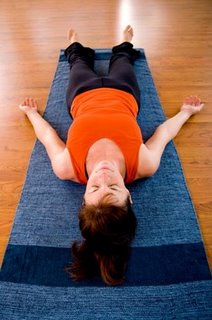 corpse yoga pose A harmonizing practice for people in recovery
As you practice the following sequence, remember to honor your limitations, going to your edge with love and acceptance rather than judgment and discouragement. If you are unable to move into a posture at this time, focus on breath-ing deeply as you think about the affirmation—that in itself is healing. At the end of the routine, take some time to write down your thoughts.
Benefits This basic pose of relaxation is done at the end of each hatha yoga session. It helps relieve the body of tension. It relaxes, rejuvenates, and replenishes the mind and body.
Affirmation I allow myself to relax completely and surrender to my Higher Power.
Lie on your back and gently close your eyes. Place your feet and legs slightly apart.
Place your arms along the sides of your body with your palms facing up. Make sure your teeth are slightly parted so that your jaw is relaxed. Start taking some deep breaths. Lie absolutely still. Close your eyes, take deep breaths, and let healing energy restore any areas of the body or mind that have been depleted by stress or tension. Visualize healing energy flowing through your entire body. Relax your body, quiet your mind, and soothe your soul. Set your Zen Timer for 20 minutes. Stay in this position until the Tibetan Bowl Gong Chimes on your Zen Timer.
adapted from Yoga Journal by Annalisa Cunningham, author of Healing Addiction with Yoga
 Walnut Wood Zen Timers with Chime for Yoga Now & Zen
1638 Pearl Street
Boulder, CO 80302
(800) 779-6383
Posted in yoga, Yoga Timer, Yoga Timers by Now & Zen
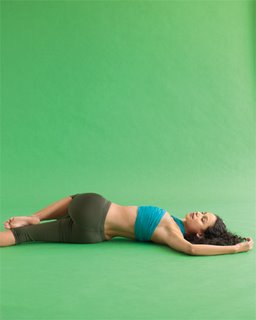 yoga A harmonizing practice for people in recovery
lwKnee-Hug Spinal Twist Jathara Parivartanasana
Benefits Releases the lower back and lengthens the spine. Increases flexibility of the spine, back, and ribs.
Affirmation Everywhere I turn I see beauty.
Lie on your back and hug your knees into your chest. Keep your knees bent into your chest and place your arms out to your sides. Your palms can be up or down, whichever feels most comfortable to you. Inhale. As you exhale, move your hips and knees to the left as you turn your head to the right. Hold the position and breathe. When you are ready, do a gentle spinal twist to the other side.
adapted from Yoga Journal by Annalisa Cunningham, author of Healing Addiction with Yoga
Posted in Chime Alarm Clocks, yoga, Yoga Timer, Yoga Timers by Now & Zen
 yoga practice A harmonizing practice for people in recovery
As you practice the following sequence, remember to honor your limitations, going to your edge with love and acceptance rather than judgment and discouragement. If you are unable to move into a posture at this time, focus on breath-ing deeply as you think about the affirmation—that in itself is healing. At the end of the routine, take some time to write down your thoughts.
Benefits Releases the lower back and lengthens the spine.
Affirmation I hold myself with compassion.
Lie on your back and bring your knees in toward your chest. Wrap your arms around your knees and legs, hugging them toward you. Keep your chin slightly tucked so your neck stays long on the floor.
Hold the position and breathe.
adapted from Yoga Journal by Annalisa Cunningham, author of Healing Addiction with Yoga
 Bamboo Zen Clocks and Chime Timers, a Natural Sound Alarm Clock Now & Zen
1638 Pearl Street
Boulder, CO 80302
(800) 779-6383
Posted in Chime Alarm Clocks, yoga, Yoga Timer, Yoga Timers by Now & Zen
 seated forward bend A harmonizing practice for people in recovery
As you practice the following sequence, remember to honor your limitations, going to your edge with love and acceptance rather than judgment and discouragement. If you are unable to move into a posture at this time, focus on breath-ing deeply as you think about the affirmation—that in itself is healing. At the end of the routine, take some time to write down your thoughts.
Benefits Helps stretch the hamstrings and lower back. It also fosters a sense of calm and letting go, while gently stretching the spine.
Affirmation I move forward with patience.
Sit on the floor with your legs extended in front of you. Sit up straight and rotate your ankles, flexing and stretching them. Keeping your feet flexed, inhale and lift your arms above your head. As you exhale, bend at the hips and lower your chest toward your knees. Keep your spine straight as you do this. Place your hands on your calves, ankles, or feet, wherever you can comfortably reach. Hold the pose for 10 breaths.
adapted from Yoga Journal, by Annalisa Cunningham, author of Healing Addiction with Yoga
 Zen Alarm Clock with Gentle Chime for Stress Reduction Now & Zen
1638 Pearl Street
Boulder, CO 80302
(800) 779-6383
Posted in Chime Alarm Clocks, mindfulness practice, Well-being, yoga, Yoga Timer, Yoga Timers by Now & Zen
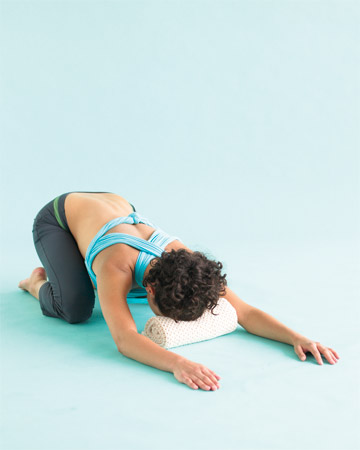 gentle yoga for people in recovery A harmonizing practice for people in recovery
As you practice the following sequence, remember to honor your limitations, going to your edge with love and acceptance rather than judgment and discouragement. If you are unable to move into a posture at this time, focus on breath-ing deeply as you think about the affirmation—that in itself is healing. At the end of the routine, take some time to write down your thoughts.
Benefits Releases tension in the shoulders and spine and relieves mental fatigue. Encourages feelings of safety and protection, as though you were in a womb of healing energy.
Affirmation I rest in trust and patience.
Begin in Sitting Mountain Pose, sitting on your feet with your toes touching and your heels separated. Inhale.
As you exhale, gently lower your head to the floor in front of your knees. Place your hands, palms up, next to your feet. Completely relax the neck and shoulders. Set your Zen Bowl/Gong Timer for 5 minutes. Hold this position while breathing for 5 minutes or as long as you are comfortable. Use pillows or bolsters for support under your torso or forehead if you have a tight lower back or stiff hips, knees, or ankles.
adapted from Yoga Journal by Annalisa Cunningham, author of Healing Addiction with Yoga
Use our unique “Zen Clock” which functions as a Yoga Timer. It features a long-resonating acoustic chime that brings your meditation or yoga session to a gradual close, preserving the environment of stillness while also acting as an effective time signal. Our Yoga Timer & Clock can be programmed to chime at the end of the meditation or yoga session or periodically throughout the session as a kind of sonic yantra. The beauty and functionality of the Zen Clock/Timer makes it a meditation tool that can actually help you “make time” for meditation in your life. Bring yourself back to balance.
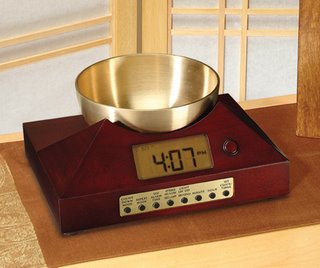 Gentle Tibetan Bowl Timer for Yoga, Meditation and a Gentle Alarm Clock Now & Zen – The Yoga Timer Store
1638 Pearl Street
Boulder, CO 80302
(800) 779-6383
Posted in yoga, Yoga Timer, Yoga Timers by Now & Zen
 yoga After a busy day of work, kids, groceries, and stressing over global warming weather conditions, how often do you sit down and think about how accomplished you are; how many people you’ve helped; how you know you can do it again tomorrow because you’ve truly got what it takes to change the world? Most likely you collapse in a heap on the couch, overwhelmed by feelings of struggle or ineffectiveness, negative self-image, inertia, or the everyday kitchen-sink blahs.
Yoga can help you through those doldrums. Like a piece of string tied around your finger, yoga serves as a reminder to acknowledge all the good things about yourself—those accomplishments and qualities you’ve somehow forgotten. It gives you the confidence and oomph you need to shift feeling states—all you need to do is roll out that yoga mat and get started. In fact, one of the first things that yoga will actually remind you about is to do yoga!
Those of us who practice yoga regularly—the precise postures, deep breathing, and meditative awareness—have learned that no matter what mood we’re in at the beginning of our yoga session, we always feel better by the end. If we start out feeling stiff, we become looser and more fluid. If we feel sluggish, our energy perks up. If we were hyper-stimulated when we first sat on our mat, we end up calmer and more balanced when we leave. On days when we’re overwhelmed, yoga brings a sense of grounding and connection. When distressing world events lead to feelings of helplessness, the strength we exert on the mat will help us tap into a sense of personal power that allows us to move forward in life. Instead of feeling pulled in all directions, we begin to feel connected to ourselves.
Yoga works like this every time, no matter what reason you have for doing (or starting) it. Getting in shape, gaining strength and flexibility, improving your posture, digestion, or sex life—all these good things are already within your grasp. That strong, fluid, healthy, sexy you is just waiting to be uncovered, just longing for an invitation to show up at the party. Yoga serves as a reminder that the strong, able, open-hearted, and confident person you wish to be already exists, at least on the inside.
I’ve had plenty of intimidating experiences that yoga rescued me from, such as the time I gave a yoga lesson to a regular private client—an upper-crust member of high society—and her guest from the British royal family decided to join in. If I had been introduced to him before the class, I’m sure my palms would have started sweating, and I would have done a Ralph Kramden, “A hummuna hummuna.” But the class was already in full swing and, filled with confidence about the benefits of yoga, I didn’t feel the least bit shy as I warmly welcomed him onto the mat.
As I made some hands-on adjustments to the now shirtless royal, I thought to myself, “Is it OK to touch someone this close to the crown?” But, at that moment, I was the expert and I knew that I could help him with his overly flexible joints. He couldn’t have been nicer and more appreciative, and we had a nice chat after the class, during which I wished I were wearing a cuter outfit.
Even though I wasn’t doing the yoga with my two students, I benefited from exploring the qualities that they were practicing under my guidance: standing on one’s own two feet, finding balance, resting in one’s breath, taking chances, being steady and straightforward, letting go, falling down, having fun, and taking a fresh start. These are all yogic gateways toward remembering the feeling of confidence in any situation.
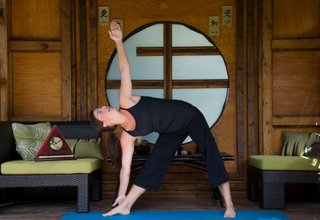 yoga Meditation master Chogyam Trungpa taught that we are all born with basic goodness, and when we acknowledge this, we connect with a sense of primordial confidence. Although this confidence already lives within us, we can sometimes lose our link to it because of negative emotions, such as fear, jealousy, or hatred. Alas, those feelings live there, too, but they don’t have to take over our entire mental and emotional landscape, leaving no room for the natural faith we have in who we are and what we can do. Just like in cooking, we can fold our natural self-confidence right into our self-consciousness to create a new and healthier blend. Who knows? Maybe with enough yoga practice, the confidence will rise to the top just like the yummy cream in a farm-fresh bottle of milk.
This yoga sequence is designed to help you develop building blocks you can use to reconnect to your own inherent self-confidence. Take your time, and try to release any expectations. The opposite of self-confidence is wishing and hoping, which always get us in trouble. Let go of that habit, and try to stay connected to your own deep breath. Have faith in your own good heart.
Mountain Pose With Arms Up. Stand with your feet directly below your sitting bones so you feel firmly planted. At the same time, actively reach through every fingertip up to the sky. This pose can be done almost anywhere, anytime, and is a great reminder of how good it feels to be able to stand on your own two feet. Let your breath be full and notice how your front, back, and sides fill with breath and soften back in toward your strong and quiet center. Hold this position for five deep breaths.
Warrior Lunge. Bend both knees. Step your left foot back, and balance on the ball of the foot. Make sure your left leg is straight with strong energy extending out your left heel. Keep your right leg parallel to the ground, knee above heel. Use your abs to keep your spine vertical. Even though your arms are getting tired, hold them up with commitment for a little longer. Let your gaze rest on something at eye level across the room to help you find balance and steadiness within the exertion of this full-body position. Stay here for three to five breaths.
Open Warrior (Warrior 2). On an exhale, turn your back heel inward and lower it to the ground, so your left foot is roughly perpendicular to your right, and the arch of your left foot is in line with the heel of your right. Pivot your hips and torso to face outward over your left foot. Extend your arms away from each other at shoulder height. As you breathe in and out for five to eight breaths, let your open body position invite you to feel expansive, open-hearted, and confident.
Reverse Warrior 2. On an inhale, lean away from your bent knee, stretching your right arm overhead as your left hand rests on your left thigh for support. Stay here for three breaths and indulge in the feeling of breath nourishing your body. Even though your legs are getting tired, can you let your breath give you a second wind? This is great practice for staying the course when you feel tired or discouraged.
Lunge. On an exhale, cartwheel your hands to the floor, on either side of your right foot. Bring your left knee to the ground with your toes pointing behind you, in line with your body. Your right knee should be over your right heel. Reach out through the crown of your head and out through your back heel. Focus on your whole body, inhaling and exhaling through your nose for five cycles.
Twisted Lunge. On an exhale, twist to the right and place your hands in prayer position. Press the back of your left elbow against the outside of your right knee as you draw up through your spine. Relax your mind once again and see if you can feel long, strong, and expansive. Stay here for 5 breaths. Lengthen your spine with each inhale, and twist a little bit more deeply (from your core) with each exhale.
Forward Fold. Exhale and place your hands on the floor on either side of your right foot. Inhale; on the next exhale, step your back foot forward and place it next to your right foot. Let your head hang between your arms and bend your knees if it’s more comfortable. Stay here for as long as you want but try to focus on your breath. Notice what the breath feels like when you are in this upside-down situation. It will be helpful when life throws you for a loop.
adapted from Natural Solutions by Cyndi Lee
Use our unique “Zen Clock” which functions as a Yoga Timer. It features a long-resonating acoustic chime that brings your meditation or yoga session to a gradual close, preserving the environment of stillness while also acting as an effective time signal. Our Yoga Timer & Clock can be programmed to chime at the end of the meditation or yoga session or periodically throughout the session as a kind of sonic yantra. The beauty and functionality of the Zen Clock/Timer makes it a meditation tool that can actually help you “make time” for meditation in your life. Bring yourself back to balance.
 Zen Alarm Clocks and Yoga Timers with Gentle Chime Now & Zen – The Yoga Timer Store
1638 Pearl Street
Boulder, CO 80302
(800) 779-6383
Posted in Yoga Timer, Yoga Timers by Now & Zen, Zen Alarm Clock, Zen Gardens
« Previous Page — « Previous Entries
Next Entries » — Next Page »
|
|
|
|